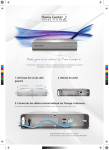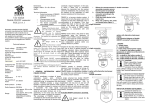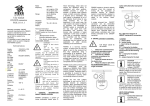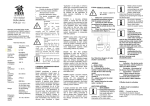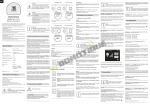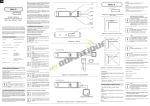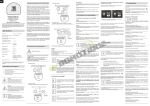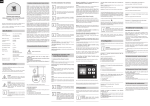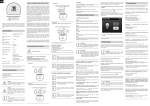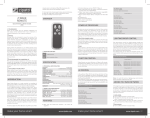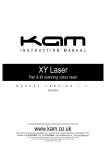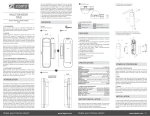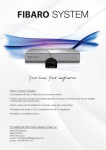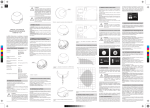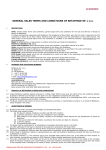Download USER`S MANUAL UNIVERSAL DIMMER 500W FGD211 v1.1.
Transcript
USER’S MANUAL UNIVERSAL DIMMER 500W FGD211 v1.1. Remotely controlled dimmer manufactured by FIBARO system is intended for work with neutral conduit or without it. It may be applied as a electronic switch within installations without neutral conduit. As a dimmer it works with the following loads: -conventional incandescent load, -halogen load of 230V - LED dimmering bulbs -low voltage halogen load of 12V (with electronic, toroidal and conventional EI transformers). Moreover as a electronic switch it may work with the following devices: -compact fluorescent lamps -LED bulbs -glow tubes with electronic stabilizers as well as with the majority of conventional stabilizers - with the application of FGB001 device it may work with optional dimmering load up to 500 W - FGB001 is an artificial load adjusted to FGD211 dimmer. It allows for dimmer’s work with loads, which do not meet the indispensable conditions necessary for the correct dimmer’s work, such as LED bulbs. They are applied in the case of the lack of neutral conduit in the connector’s box. Technical features: Supply voltage 230 V ±10% 50Hz Input power 25-500 W Conformity with the EU norms Overcurrent protection EN 55015 (interferences) EN 60669-2-1 (exploitation safety) 2,5A System temperature limitation 105 °C Work temperature 10 - 40 °C For assembly in boxes Ø ≥ 50mm Radio protocol Z-Wave Radio frequency 868 MHz Range up to approx. 50m on the open area up to approx. 30m on the building premises (depending on building materials) Dimensions (height x width x depth): 15 x 42 x 36 mm Technical information Control via devices of FIBARO system or of any Z-wave controller. Microprocessor control. Executive element: triac. Soft start. Possibility to work in stair and bent interior system Memory of the last setting of lighting level. The device co-operates with mono-stable and bistable keys. DANGER Danger of a fatal electric shock! All of the works connected with the execution of device’s assembly may be conducted only by a qualified and authorized electrician. The national law regulations have to be observed. DANGER Life danger caused by the current. Even when the device is turned off there may be voltage on its output. All of the works, which aim at the change of setting configuration or of load change should always be executed with the voltage turned off by the previously turned on safety device. CAUTION The connected load as well as the dimmer may be damaged, should there be applied loads incompatible with technical specifications (see: Technical data). • During its exploitation the dimmer requires minimal load of 25VA (or in the case of connection of FGB001 device - 0,5VA) – do not connect power supply without the load. • The dimmer may only be connected with the lighting. • The dimmer may be connected only in accordance with a diagram shown within the user’s manual. Incorrect connection may result in a risk for health, life or may cause property damage. Hints • The dimmer must not be connected do the load heavier than recommended (details in technical data). I GENERAL INFORMATION ABOUT FIBARO SYSTEM: FIBARO constitutes a system of house automatics based upon Z-Wave technology, which does not require any additional wiring. In comparison with other systems, FIBARO provides a range of benefits. In general radio systems create a direct connection between a receiver and a transmitter. The radio signal is dampened by all of the obstacles found along its way (walls, furniture, etc. in the apartment). In the worst case, the radio system will cease to perform its functions. The advantage of FIBARO system is constituted by the fact that apart from both transmitting and receiving the devices also constitute a signal “duplicator”. In the case, in which a direct way of connection between the transmitter and the receiver cannot be established, the connection may be realized via the application of other devices mediating in the transmission. FIBARO is a two-way wireless system. It means that not only the signal is sent to the receivers but that they additionally send a confirmation of its reception. Thus, they confirm their state so that we may verify whether the device has actually been turned on. The safety of FIBRO system transmission is comparable with wire systems. FIBARO works within a free band for data transmission upon the frequency of 868MHz. Each FIBRO network possesses its own unique home ID number. Therefore, there is a possibility to co-exist for two or more independent systems within one building without any conflict. Despite the fact that Z-Wave technology is new, just as Wi-Fi it officially became an obligatory standard. Many manufacturers from different fields offer solutions based upon the Z-Wave technology and they are mutually compatible. Such a situation results in the fact that the system is future-prospective and will allow for further development. More information may be found on the following website: www.fibaro.com. FIBARO creates a dynamic network structure. From the moment of turning off, the placement of particular devices of FIBARO system is automatically updated in the actual time via confirmation of states in the working “mesh” network. A single universal box dimmer will be hereinafter referred to as dimmer. With its application one may turn on and dim the lamps (see: Technical data) via radio waves, controllers and a key directly connected to the dimmer. The dimmer automatically recognizes connected load, is protected against overload, short-circuit, works noiselessly and has a function of “soft” start, which allows for a mild brightening of the connected load (in the case of fluorescent lamps and other specific lamps, e.g. in the case of lamps with a starter or some transformers of old type there only exists a possibility to turn the light on/off without the possibility to dim it). II Dimmer’s assembly Life danger caused by the current. 1. 2. 3. 4. Before the commencement of assembly procedure ensure that the power is turned off. Connect the dimmer according to the diagram below. Place the whole device in the electric box. Place the antenna (the hints are located below figure 1 and 2). a single connector a double connector Fig.1 Electrical diagram of dimmer’s connection – without neutral wire a single connector a double connector Fig.2 Electrical diagram of dimmer’s connection – witch neutral wire LEGEND: L – phase clamp N – neutral clamp Px – optional output clamp for buttons powering (internally connected to L clamp) P1 – a clamp for the button number 1 (possesses an option to set the device to the learning mode) P2 – a clamp for the button number 2 OUT – dimmer’s output clamp (control via additional lighting or other load) HINTS FOR ANTENNA SETTLEMENT: Conduct the antenna at a possibly long distance from metal elements (connectors, ring brackets, etc.), in order to prevent interruption of the radio signal. Metal surfaces located within the nearest surroundings (e.g. metal boxes mounted under plaster, metal frame slats) may influence the reception capacity, thus worsening the range of the device work! Do not cut or shorten the antenna. Its length is perfectly adjusted to the band, within which the system works. ----------------------------------------------------------------------------------------------------------------------------------------------------------------- Caution! It has to be emphasized that the key connected to the P1 clamp is a superior key. It activates basic dimmer’s functionality (turns the light on/off/ dims the light) as well as activates the device’s learning mode (Include/Exclude). The key connected to the P2 clamp is an optional key. Thus, pushing it, without the implementation of changes into configuration parameters, has no influence on the device’s state. DICTIONARY: • INCLUSION • • • - the device sends Node Info frame, which enables to add it to Fibaro system (Home Center) EXCLUSION - the removal of the device from Fibaro radio system ASSOCIATION - control of other Fibaro system devices MultiChannelAssociation - control of other multichannel devices within Fibaro system. III Dimmer’s activation 1. Dimmer’s installation procedure STEP 1 Connect the device according to the electric diagram shown on figure 1. Turn off the power supply 230V. [Addition or removal of] the dimmer [to or from] z-wave network [Inclusion/ Exclusion] STEP 2 The dimmer must be located within the range of Home Center controller, because the mode of adding to Fibaro system requires the direct communication with the controller. (distance up to 40m) STEP 3 Identify key number 1. The key, which turns the light on (see: CAUTION II for the bipolar switch) STEP 4 Set Home Center controller on the mode of adding or removing of the device to/from the network (see: the instruction of Home Center controller) STEP 5 The dimmer enters the mode of adding and removing after a quick triple clicking of the key connected to the P1 clamp (key number 1) CAUTION I: The dimmer cancels the learning mode after a single pushing of the key number 1. Thus, the quadruple pushing of the key number 1 will not add the device to the network. CAUTION II: The dimmer is adjusted to work with monostable switches (that is unipolar switch or bell switch) by default. In the case of adding to the network the dimmer with bistable switch verify whether all of the switch’s contacts are open (turned off), because the switch’s short-circuit means turning off of the key, which will disable the correct process of adding of the dimmer into FIBARO system. During installation time it is recommended to use mono-stable keys! STEP 6 The correct process of adding of the device to the network will be signalled on the controller (see: Home Center controller’s instruction). 2. Dimmer’s reset procedure The dimmer has got two procedures, which enable to reset the device. Method I Via the procedure of removing (“exclusion”) of the dimmer from the existing Z-Wave network. It is conducted with the application of a controller, which possesses the function of adding and removing (inclusion/exclusion) of devices from Z-Wave network (see: Home Center controller’s instruction). Such a controller does not have to be a part of the network, which hosts the removed device. Method II To reset dimmer settings: connect power and until 5 seconds click button P1 and hold button P2 3. Control of the dimmer via connector. Mono-stable connector (after the key release the spring automatically bounces, causing disconnection) Turning the lights on/off: shortly push the key number 1. The dimmer will turn on always with the previously set brightness. Brightening/dimming of the light: hold the key number 1. CAUTION The dimmer always comes to the extreme value of 1% or 100%. In order to change the function of brightening/dimming, release the key number 1 and hold it anew. CAUTION Should one of the keys be hold in order to fluently change the light intensity, the other one does not react to any commands. − Turning the light 100% on: quickly double click the key number 1. The dimmer will generate the load of 100%. The previously set value will be reset. Bistable connector (acts as a switch – does not going back after the key release) − − Turning the lights on/off, the change of position of the key number 1. The dimmer will turn on always with the previously set brightness. Turning the light 100% on: quickly double click the key number 1 (stands for the double change of the key position up or down). The dimmer will turn the lights 100% on. CAUTION The key number 2 may be ascribed the control of other devices (see: ASSOCIATION) 4. Control of the dimmer via ALL ON / ALL OFF command The dimmer executes ALL ON / ALL OFF commands, which may be sent via Home Center or other controller, which belongs to the system. Usually ALL ON / ALL OFF commands are implemented within remote controls, which use z-wave protocol and are applied for issuing of commands directed to the whole system. Both ALL ON and ALL OFF commands are accepted by the dimmer by default. The implementation of changes may be executed by means of saving the correct value into the configuration register number 1 (see: configuration register). Thus, we may determine to which commands our device is supposed to react. 5. Dimmer’s controller via main controller of Fibaro system (Home Center) After the conduction of procedure of adding of dimmer into the network, it will be represented within the Fibaro system controller by means of the following icon: The process of dimming/brightening is executed by slider moving. The current dimmer’s state is signalled on the bar chart. ON/OFF –ON and OFF icons are used for complete dimmer’s brightening or dimming Fig. 3 Dimmer’s icon within Home Center controller IV Association The application of association allows dimmer to directly control the other device within z-wave network, e.g. other dimmer, transmitting connector, roller blind. CAUTION Association allows for sending of direct control commands between the devices and the main controller, but it does not participate into the process of communication. The dimmer allows for association of two groups. 1. The group is ascribed to the key number 1 2. The group is ascribed to the key number 2 The dimmer enables the control of 16 ordinary devices and 7 MultiChannel ones, 1 field out of which is reserved for the network controller. It is recommended not to use more than 10 devices because the time required by the device to issue a command to each of the associated device may be very long. In order to add an association (with the application of Home Center controller) one has to move to the device options, clicking on the following icon: Choose device options. Then determine the group and the type of device to be associated. The process of sending by the controller of the proper information to the devices included in the associated groups may take even several minutes. CAUTION If during the time, in which the device sends control commands, the key is pushed anew, the process of sending of present commands will be interrupted and the process of sending of new commands will occur. V Configuration In order to move to the dimmer’s configuration (with the application of Fibaro controller) move to the device options, clicking on the following icon: Choose device options. Parameter number 1 – Activation/deactivation of ALL ON/ALL OFF functions default value 255 Possible configuration parameters: 255 ALL ON active ALL OFF active. 0 Default ALL ON non active ALL OFF non active 1 ALL ON non active ALL OFF active 2 ALL ON active ALL OFF non active Parameter number 7 – The type of control frame for associated devices default value 0 Possible configuration parameters: Ascribed devices associated to FGD211 obtain the following control frame: 0 - Switch Multilevel Set – allows for control of all the devices, which accept Switch Multilevel Set frame 1 – Basic Set – allows for control of any device within Z-wave network, apart from the devices poweres by batteries. Parameter number 9 – The time of travel between extreme values of dimming level with manual control. default value 5ms (0,05 s) The possibility of parameter change 1-255 ms (0,01s – 2,5s) Parameter number 10 - The time of travel between extreme values of dimming level with remote control. default value 1 The possibility of parameter change 0-255 (0s – 2,5s) 0 – the value turns off the fluent change of light intensity CAUTION the value 0 is required for devices, which are adjusted to dimming as well as for inductive and capacitive devices (e.g. fluorescent lamps, motors, etc.) Parameter number 11 – The percentage drop of regulation per one dimming step with manual control default value 1 The possibility of parameter change 1 -99 Parameter number 12 – The maximum level of dimmer’s brightening default value 99 The possibility of parameter change 2-99 Parameter nr 13 – The minimal level of dimmer’s brightening default value 2 The possibility of parameter change 1-98 CAUTION The value of maximal level cannot exceed the value of minimal level. Real value Virtual value Parameter 12 and 13 (max and min level) is recommended to be set for the control of the following devices: • Alternating current motors [min 60%, max 99%] • Fluorescent lamps, Fluorescent lamp, LED [min 98%, max 99% ] [Set parameter 10 for 0] Parameter number 14 – The type of switch may be chosen from mono-stable or bistable switches default value 0 The possibility of parameter change” 0 – mono-stable switch 1 – bistable switch Parameter number 16 – Saving of the device state after the power supply black-out. The dimmer will return to the last state before the power supply black-out. default value 1 The possibility of parameter change: 0 – the dimmer does not save the state after the power supply black-out; it returns to the turn off state 1 – the dimmer saves the state before the power supply black-out Parameter number 17 – stair button function allows to double the key number 1. The dimmer may operate two bistable keys or an infinite number of mono-stable keys. default value 0 The possibility of parameter change 0-1 0 – stair button function off 1 – stair button function on Parameter number 18 – The function of synchronization of the light intensity for associated devices. The dimmer transmits this state to the associated device. default value 0 The possibility of parameter change 0-1 0 – function off 1 – function on ADVANCED FUNCTION Parameter number 20 – Function, which allows for the change of control impulse length. default value 110 The possibility of parameter change 100 - 170 The function allows for lowering of the minimal dimmer’s level via lengthening of control impulse. By the means of minimal level change, the dimmer allows for the complete dimmering of LED bulbs. Not all of the LED bulbs available on the market allow for dimming. CAUTION !!! The incorrect function setting may cause incorrect work of the dimmer. VI Dimmer’s operation The dimmer may be operated via the following operational elements: - any controller compatible with the system (e.g. Home Center controller) - mobile phone (e.g. IPhone as well as mobile phones of other manufacturers equipped with appropriate control application) - devices of tablet type (e.g. IPod) - via PC, with the use of internet browser - via the key connected to the dimmer VII Procedures conducted in the case of interruptions The device does not react to the programmed transmitter: • Ensure that the maximal range was not exceeded and that on the signal way there are no obstacles, such as metal surfaces, e.g. metal wardrobes, reinforced ceilings and bearing walls, etc. • Ensure if the device is not set to program mode. • Repeat the process of programming one more time. IX TERMS AND CONDITIONS OF THE GUARANTEE 1. The Guarantor of the Device quality is FIBAR GROUP Sp. z o.o. (hereinafter referred to as „Manufacturer”) domiciled at Poznań, 6A Człopska Street; 60-453 Poznań, entered into the National Court Registry by the Regional Court in Poznań, 8th Economical Department of the National Court Registry, under the KRS number of: 370151, NIP 7811858097, REGON: 301595664, with company equity of 5000 PLN. 2. The Manufacturer shall bear the responsibility for the improper work of the Device, which stems from the physical defects (material or production defects) found in the Device within the period of 12 months from the day of its sale. 3. The Guarantee is in force and is applied only on the territory of the Republic of Poland. 4. During the period of Guarantee validity, the Guarantor shall be obliged to remove the revealed defects free of charge by means of repair or replacement (at the Guarantor’s sole discretion) of all of the defective Device’s elements for new or regenerated and undamaged elements. In the case of the lack of possibility to perform repair works, the Guarantor reserves the right to replace the Device for a new or generated and undamaged one, whose physical state shall not be worse that the state of the Device owned by the Client. 5. Should in special cases (e.g. the lack of Device within the commercial offer) the replacement of the Device for the one of the same type be impossible, the Guarantor may replace the Device for another one, with possibly most similar technical parameters. Such an action shall be considered as the execution of the Guarantor’s duties. The Guarantor shall not refund money spent on the purchased Device. 6. The owner of the valid Guarantee document reports the claims with regard to the Guarantee via guarantee service. One should remember that before the report of guarantee claim it is useful to contact our company via telephone or via the internet technical assistance. In more than a half cases, the Client’s problems are solved remotely, the fact, which allows to avoid the loss of time and costs with regard to the unnecessarily activated Guarantee procedure. Should the remote solution of the problem be impossible, the Client will be asked to fill in the application form in order to obtain authorization via internet website www.fibargroup.com In the case of reporting of a correct claim You will receive the confirmation of its reception as well as a unique report number (RMA). 7. There is also a possibility to report the claim via telephone call. In such a case the call will be recorded, the fact about which the Client will be informed by the consultant before the acceptance of claim report. Immediately after the report reception rhe consultant will inform the Client about the report number (the so-called RMA). 8. In the case of reporting of a correct claim the representative of the Authorized Guarantee Service (hereinafter referred to as “AGS”) will contact the Client and determine the day and the place of the visit of technicians, who will check the correctness of Device’s functioning in presence of Client. 9. The defects revealed during the period of Guarantee validity shall be removed within 30 days at latest, counting from the date of delivery of the Device to AGS. The period of Guarantee validity shall be extended with time, in which the Device is kept by AGS. 10. The claimed Device shall be rendered accessible by the Client with the complete standard equipment and documents confirming its purchase. 11. The elements replaced with regard to the Guarantee constitute the ownership of the Manufacturer. All of the elements enumerated within claim process are encompassed with the Guarantee valid until the period of validity of the Device’s basic Guarantee. The period of Guarantee validity for a replaced element is not subject to extension. 12. The cost of travel to the claimed Device or of its delivery to the service shall be borne by the Guarantor. In the case of an unjustified summoning of the service, the Service has a right to impose on the Client the costs of travel and manipulative costs connected to the explanation of the matter. 13. AGS rejects to accept the claim only in the following cases: - in the case, in which the Device is exploited against its intended use and the user’s manual, - in the case, in which the Client renders accessible the Device, which is incomplete, has no fittings or data plate, - in the case, in which the defect is different than material or productive one found in the Device, - in the case of the invalid Guarantee document and the lack of purchase receipt, 14. The Guarantor shall not be responsible for the defects in property caused by the defective Device. The Guarantor shall not be responsible for indirect, collateral, special, consequential, or moral losses, nor for damages, including lost benefits, savings, data, advantages, third party’s claims as well as any other property or personal defects resulting from or connected to the exploitation of the Device. 15. The quality Guarantee does not encompass the following issues: − − − − − the defects caused by the external reasons, such as: flood, thunderstorm, fire, lightning stroke, calamities, earthquakes, wars, social unrests, force majeure, unforeseen accidents, robbery, liquid flooding, bacteria leakage, weather conditions, the influence of sunbeams, sand, humidity, high or low temperature, air contamination; the defects caused by the improperly working software, as a result of virus attack or caused by the lack of conduction of software updating procedure according to the Manufacturer’s recommendations; the defects caused by: overvoltage within the power supply and/or telecommunication network or by the execution of the Device’s connection via a method incompatible with the user’s manual or by connection of other products, whose connection is not recommended by the Manufacturer; caused by the work or storage of the Device in the extremely unfavourable conditions, that is in the presence of high humidity, dustiness, too low (frost) or too high temperature. The detailed terms and conditions, in which the Device may be exploited are determined within the user’s manual; − the defects caused as a result of exploitation of accessories not recommended by the Manufacturer; − caused by the defective electrical installation conducted by the user, including the application of incorrect safety devices; − − − 16. mechanical defects (cracks, breaks, cuts, wears, physical misshapes caused by a blow, fall or dropping on the Device of another object or caused by the exploitation against the Device’s intended use determined within the user’s manual); the defects caused by the Client’s negligence of conduction of maintenance and service procedures enumerated within the user’s manual; the defects caused by the exploitation of non-original, spare parts and equipment parts inappropriate for a given model, execution of repair works or changes conducted by unauthorized persons; the defects caused by continuity of work with defective Device or fittings. The scope of the Guarantee repair work does not encompass periodical maintenance or inspection of the Device, especially cleaning, regulations, verification of functioning, correction of service errors or software parameters or other activities, which should be conducted by the user (the Purchaser). The Guarantee does not encompass the natural wear of the Device’s elements as well as of other parts, which possess determined period of functioning and are enumerated within the user’s manual and technical documentation. 17. Should the type of product’s defect be not encompassed within the Guarantee, the Manufacturer reserves the right to remove such a defect at his own discretion, conducting the repair of the defective or damaged part or rendering the sub -assemblies accessible for the conduction of the necessary repair works or replacement. 18. The Guarantee for the purchased goods does not exclude, limit, nor suspends the Purchaser’s rights stemming from the product’s incompatibility with the agreement. The device may be used with all of the devices, which possess Z-Wave certificate; It should also co-operate with the devices manufactured by different manufacturers. Every device, which is compatible with Z-Wave may be included in Fibaro system. FIBARGROUP FIBARO In the case of technical questions please contact the client service centre in Your company. www.fibargroup.com










